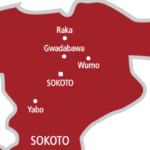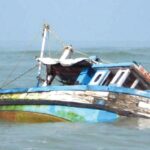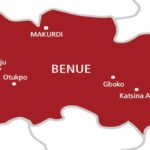Over 250 people have been killed in 2021 as a result of boat mishaps in Nigerian waters, an investigation by Daily Trust has revealed.
Experts on water transportation attributed the incidents to lack of enforceable regulations and policy direction.
- Govt commences sale of 600 bags of fertilizer
- A Typical Nigerian Week: Tomori’s Tears, Travel Apartheid and Sokoto’s corpses
They also said thousands of Nigerians who relied on water transportation used crude methods to improvise boats and badges and rarely took safety measures while navigating the waters with huge loads and people.
According to the National Inland Waterways Authority (NIWA), Nigeria’s resource base of waterways spans 10,000 kilometres; with about 3,800 kilometres of it “navigable seasonally”.
However, the Daily Trust investigation found out that rather than help to improve the movement of humans and goods, these large water bodies which connect 28 of the 36 states of the federation have become gateways of tragedies due to the near absence of infrastructure and supervision.
In the most recent occurrence on November 30, 2021, at least 29 people out of the over 50 people aboard the locally manufactured boat, among them Islamiyya school children, were confirmed dead in the boat mishap in Bagwai Local Government Area of Kano State.
Speaking on the incident, the police spokesperson in Kano, Abdullahi Kiyawa, said 29 passengers were confirmed dead by medical doctors while seven others were rescued with others missing.
River transportation, which is the least developed transport system in the country, led to the death of 156 persons in Warrah village and Tsihuwan Labata in Ngaski LGA of Kebbi State in May, the highest fatality recorded so far in 2021.
An analysis by Daily Trust indicates that 78 persons survived from 12 boat mishaps in 2021, while 32 others are still missing.
A breakdown of the cases shows that one person died in the Badagry Water Channel in Lagos State, while 30 others lost their lives in the Tijana River in Niger State, and seven persons declared missing.
The Adekunle Jetty in Lagos also claimed one life while 16 others survived during in an incident. The Iyansan Waterway in Ondo claimed the lives of two persons, with four others surviving. At Idiogba in Ilaje LGA of Ondo State, one person died with 15 surviving during in boat mishap.
The Warri River in Warri South-West LGA also saw the death of two persons.

Similarly, Doruwa to Ginga waterway in Sokoto State saw the death of 13 persons who were mostly women, children and the elderly. At the Mayo Renewo Village side off the River Benue in Taraba State, five persons died with nine surviving, with five declared missing. Farar Doka Stream also claimed five persons, while four survived.
At Gamafoi Village in Kafin Hausa LGA in Jigawa State, seven persons died in a boat mishap with three others surviving.
Daily Trust recalls that besides the lives lost in the outgoing year, hundreds of people also died in 2020 due to accidents on waters.
Speaking on this, the Chairman of the Governing Council of the Hydroelectric Power Producing Areas Development Commission (HYPADEC), Joseph Ityav, said no fewer than 350 lives were lost to boat mishaps in Nigeria in 2020.
Mr Ityav disclosed this in Borgu, Niger State, at the flag off of the cutting of tree logs and removal of debris on Kainji and Shiroro lakes.
He blamed most of the mishaps on poor conditions of boats, overloading, unavailability of life jackets and the preponderance of logs on the waterways.
Untapped huge potentials
Data on NIWA’s website indicates that 28 of the nation’s 36 states can be accessed through water and that Nigeria can link five of its neighbouring countries: Benin Republic (Port Novo), Equatorial Guinea, Cameroon, Chad and Niger Republic by water.
The River Niger and River Benue constitute the major channels for inland navigation, which include but are not limited to, the Cross River, Port Novo- Badagry-Lagos waterways, Lekki and Lagos lagoons, Ogun-Ondo waterways, Benin River, Escravos Channel, Nun River, Imo River, Orashi River, Ethiope River, Ugwuta Lake, Lake Chad and numerous creeks in the Niger Delta.

States in the Niger Delta for instance have unspecified sizes of waterways which the states are still struggling to utilise.
Lagos State has a sparse landmass estimated to be about 0.4 per cent of the entire Nigerian landmass with massive waterways.
Though Lagos probably has the best water transportation system in the country compared to others, the state has not yet fully taken advantage of the vast waterways to ease pressure on its roads.
Governor Babajide Sanwo-Olu said traffic management and transportation was one of the cardinal programmes of his administration encapsulated in the THEMES agenda, assuring that his government would develop inter-modal transportation to ease the pressure on the roads.
The Lagos State Ferry Service (Lagferry) said necessary facilities had been put in place to begin ferrying no fewer than 480,000 Lagosians daily to their various destinations through the state’s waterways safely and securely.
Lagferry recently increased its service boats to 20, according to the Managing Director of the agency, Abdoulbaq Ladi-Balogun.
Bayelsa State, created on October 1, 1996, has one of the longest waterways made up of rivers, estuaries, creeks and swamps.
The state, bordered by the Gulf of Guinea and the Atlantic Ocean, sits on a total area of 10,773km² – land and rivers.
Aside the exploration and exploitation of oil and gas on the seashores of the state, the abundant potentials in the waterways have not been fully harnessed for economic gains.
The waterways in Cross River State are said to be massive and being explored by more people and businesses. The waterways stretch from Calabar into the Atlantic Ocean.
From Calabar, residents access Oron in Akwa Ibom State, as well as Cameroon, Equatorial Guinea, Gabon, Sao Tome and Principe by water.
Private water transporter, Ibom Ferries, is now launching bigger vessels to ease travellers’ plights and nightmares on the federal highways in the state.
In Ogun, Ogun Waterside LGA is believed to be the only area of the state with a coastline on the Bight of Benin and also which borders Lagos Lagoon.
Findings show that water transportation is still underdeveloped and underutilised in Nigeria, with reports indicating low usage of inland waterways due to lack of facilities.
Sadly, there is no state agency in most of the states in the North, specifically tasked with the responsibility of managing the inland waterways.
NIWA infrastructure abandoned
Investigations by our reporters revealed that infrastructure belonging to NIWA at the four river ports and jetties across the nation are currently in different states of abandonment despite the huge budgetary allocation which the agency received from the federal government in the last three years.
The federal government, in 2018, allocated N13.7bn for the rehabilitation of four river ports: Lokoja in Kogi State, Baro in Niger State, Onitsha in Anambra State and Oguta in Imo State.
While the government disclosed that two of the river ports, Onitsha and Baro, had been completed, Oguta and Lokoja have allegedly been abandoned by the contractors.
The Lokoja River Port in Kogi State was awarded in 2011/2012 at the cost of N4.1bn to Inter Bau Construction Ltd and was expected to be completed in three months. The port is also in a state of abandonment.
The Oguta River Port in Imo State was also awarded at the same time to Scott Amede Engineering Ltd for a fee of N2.7bn.
Similarly, the Onitsha River Port was initially built in the 80s by President Shehu Shagari and was rehabilitated by President Goodluck Jonathan’s administration at a whopping cost of N4.6bn in 2012.
In the last nine years, NIWA had on several occasions said the inland river ports had been completed and would “soon” be concessioned. This has not happened.
An expert on water transportation, Hamisu Aliyu, said it would be very difficult for Nigeria to get value from the investments it had made on water transportation.

Aliyu said, “What we have is haphazard interventions, and we would never get it right. There is no holistic approach, and that is why the Baro and Onisha ports are all not functioning.
“They cannot function in isolation because the water channels are interconnected. We don’t give priority to dredging the rivers to allow unhindered navigation.”
Another water expert, Maxwell Ken, said Nigeria would have saved lives and billions of naira if “our transportation system is functioning.”
He further said, “Millions of Nigerians would have migrated. Imagine travelling from Lagos to Kogi, Benue and Taraba states through the rivers; or from Sokoto to Niger. It would be cheaper, safer, more convenient, and above all, we would save our roads degradation because of pressure from heavy trucks conveying goods across the country.”
Daily Trust investigation also revealed that important jetties under construction by NIWA along the inland rivers appear to have been abandoned. These jetties are located in Lokoja, Oguta, Degema, Onitsha, Owerrinta, Ndoni, Pategi, Burutu, Yenagoa, Baro, Igbokoda and Ondo.
Also abandoned are the multi-million naira underway weed removal machines and the navigational equipment installed in the nation’s inner waters.
But the manager in charge of the Lagos Area office of NIWA, Engineer Sarat Braimah, said the underwater weed removal machines were deployed regularly along Lagos coastal areas.
However, Engr Braimah said, “Despite this, this water hyacinth still impedes seamless navigation from Badagry to Lagos Island, and from Ikorodu, Epe to Lagos Island.”
He further told our correspondent that several swamp buggies were deployed along the coast to assist in that regards.
There’s no framework for water transport – Don
Speaking with one of our correspondents, a Professor of Transportation, Samuel Odewunmi, decried the lack of a policy framework to make water transportation work.
He stated that there should be a holistic solution to driving waterway transportation.
He further said, “Access to the jetties is important. Then the jetty itself has to be safe, accessible and you have to make sure the jetties are comfortable when the water recedes. So three elements are important, especially access to the jetties.
“Then most of our boats are open boats, except the Lagferry boats in Lagos, and when it rains, you are drenched. These are basic things.
“Then the routes. You have to clear the channels throughout the year so that they are navigable; so that the boats would not get grounded. Then you have to clear the water hyacinth. Then if it is a longer trip, you want to go to Warri from Lagos and so on, security comes in. You need water police to protect people. All the bigger ships are going around with their armed guards.”
By Sunday M. Ogwu, Faruk Umar (Abuja), Abdullateef Aliyu, Eugene Agha (Lagos), Bassey Willie (Yenagoa), Eyo Charles (Calabar) & Peter Moses (Abeokuta)

 Join Daily Trust WhatsApp Community For Quick Access To News and Happenings Around You.
Join Daily Trust WhatsApp Community For Quick Access To News and Happenings Around You.


